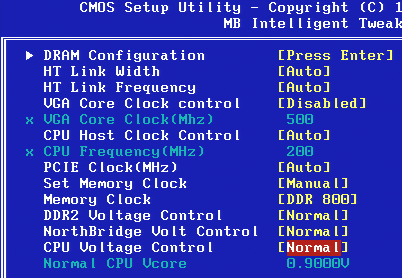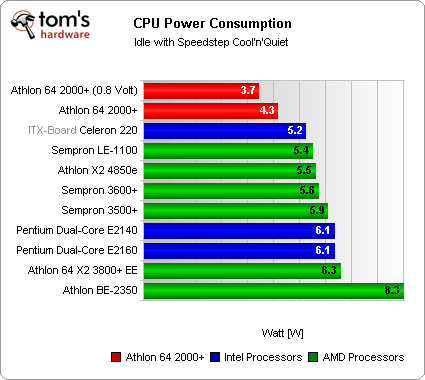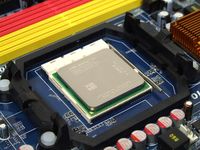Athlon Vs. Atom: Duel Of The Energy Savers
Processor Power Consumption
Power Management
Like the Atom 230, the Athlon 64 2000+ does not have any extra power management functionality and therefore no Cool’n’Quiet energy-saving mode. There is no need for it, as the processor already operates on the lowest possible multiplier of x5 to reach a frequency of 1 GHz—Cool’n’Quiet would not be able to lower the frequency any further anyway. Furthermore, the Athlon 64 2000+ runs at 0.900 V, which is already lower than the voltage of other common models with Cool’n’Quiet activated. The Athlon 64 2000+, by our measurements, consumes only 4.3 watts.


If we manually set the core voltage to the lowest possible level of 0.800 volts (undervolting), the energy consumption drops from 4.3 watts to 3.7 watts under idle conditions.
Under full load conditions, AMD’s 8 watt Athlon 64 2000+ consumes roughly 7.2 watts. With the reduction in voltage, the power consumption drops further, down to 6.1 watts. With the reduced core voltage, the processor was stable during a test phase with Prime95 under full load conditions.
The Gigabyte GA-MA78GM-S2H we used in our test is equipped with 4-phase power. If a manufacturer optimized a 780G for low power CPUs and used a single phase, then the energy consumption of the Athlon 64 2000+ would be significantly lower.
We could not directly measure the energy consumption of the Atom processors, because the embedded board does not grant direct access to the 12 volt power line.
Get Tom's Hardware's best news and in-depth reviews, straight to your inbox.
Current page: Processor Power Consumption
Prev Page System Power Consumption Next Page Web Browsing Speed-
wh3resmycar oh please, spare me those kind of crap...Reply
clearly the 780g platforms owns any nvidia/intel chipset to date.
about the article:
this is a winner, i mean this is like the ultimate HTPC setup you can ever have.no heat/power worries just plain movie enjoyment :D -
photoguru wow... good choices for matching mobos... why even take the time to write these articles? If you're comparing HTPCs that are low cost, efficient, and fast enough for encoding and decoding then do it with the right gear. Don't tell me that an ultra mobile processor just got pwned by a desktop chip unless they figured out how to make that desktop chip fit in an ultra mobile form factor.Reply
It doesn't make sense to compare them on those terms unless your entire argument is based on wattage and not actual form factor performance.
I will say that it would be interesting to find out what combination of low cost parts makes the most reasonable HTPC as far as performance/cost goes (with watts and temps included in case we could passively cool these babies). -
guusdekler Tom's choice of AMD hardware is a bit shortsighted in my opinion.Reply
There exist a lot more options that the matx board of his choice.
Let me name some of the MINI-ITX boards there are for AMD AM2 AM2+:
- Albatron KI690-AM2
- AOpen NMCP68ST-LA
- JetWay NC62K-LF
- MSI Fuzzy 690T
Allricht they employ a different chipset than the 780G but still very competetive as i derive this information from a dutch hardware magazine that tested these boards against intel's solution and especially the AOpen and MSI boards beat the crap out of intel's D201GLY2 board. -
apache_lives see this is what AMD is all about!!!!!!!!!!!Reply
Intel - produces first generation, limited, expensive and unflexible setups, AMD creates a cheaper flexible option for the masses, which kicks Intel back in line.
This opens the low power platform up to all new ideas, and allows vista to run properly thanks to the video performance etc, and ram support.
Nice one AMD! -
Wow! great, I hope next time, in 45 nm AMD will bring 2 phenom in one socket and become the new Phenom X8(like Intel pentium D) its just kick the new Intel Core i7. He, he, he...Reply
-
venteras I agree with photoguru, this is a pointless comparison. If you don't use the same form factor, i.e. mini-itx for both of them then what's the point? Unless if you want to disregard size and only compare performance/watt. However, since the whole point of the ATOM is to go 'smaller'... yeah, whatever.Reply
-
nottheking I must say I'm a bit surprised at the results. It's good to see that perhaps there's more life (and use) left in Athlon64s than we'd previously thought, if they make ideal low-power CPUs. Likewise, it's a surprise to find a place where AMD trumps Intel in the performance-per-watt sector, which is always important; I can perhaps imagining chips like the 2000+ and Atom being used for low-maintenance servers and datacenters, where PPW has always outweighed raw performance, since it's infinitely easier to buy more chips than to upgrade the local power grid.Reply
Now, if only Intel would develop an Atom-specific chipset that didn't consume copious amounts of memory. If AMD can get low-end GPU power sufficient for high-def decoding (regardless of what the CPU is) in under a single watt, certainly Intel could make a chipset that can handle all that is done by the 945GC and its laughable GMA 950 in even less power, since we're talking a less-complex design that has considerably less graphics power on hand, as well as the fact that Intel has access to 45nm production right now, while AMD is still stuck with 55nm. If only the chipset for an Atom didn't have several times the thermal envelope of the CPU...

